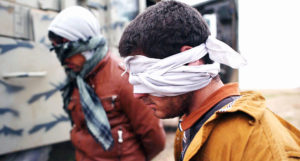In his review of The Texas Chainsaw Massacre, a spectacularly violent horror film that set the stage for the even more spectacularly violent slasher films of the Eighties, David J. Hogan described it, approvingly, in this way:
“The most affecting gore thriller of all and, in a broader view, among the most effective horror films ever made… The girl watches as her unconscious boyfriend is cut into fillets by a chainsaw. As the afternoon wears into night, more of the youngsters are stalked and murdered … What is remarkable … is that its outrageous horrors seem entirely real.”
The remarkable thing about Isis execution videos, of course, is that the outrageous horrors staged in them are entirely real. You can point to the strategic logic behind the videos, if you want. You can say that they serve an instrumental purpose, that terrifying violence works, that it pushes people away, while drawing others in. But you also have to acknowledge the total insanity of the videos. They are insane. The violence is terrible, graphic, excessive and real. Despite (or because of?) this, large numbers of people have watched them. What prompted them to do so and what impact, if any, did the videos have on them?
In my efforts to find out I spent three months in 2017 closely tracking four popular internet shock-sites. During this period, I watched scores of appalling videos and read thousands of comments that forum-members had made in response to them, focusing on jihadi execution videos. I collected thousands of member-posts that spoke to or touched on the issue of motive, and I interviewed several prolific gore enthusiasts who had shared and commented on jihadi execution videos. I also interviewed the sites’ founders to ask them about the voluminous amounts of jihadi content on their sites and what they thought about this.
Gore fans are naturally defensive about their specialist interest, as well they might be. It is one thing to watch an actor scream and squirm in a scene of simulated torture, but quite another to watch a real person scream and squirm at the hands of a real torturer. We all recognise this elemental distinction, and we all recognise the line we cross when we watch real, as opposed to fictional, victimisation on camera. Gore fans live over on the other side of that line.
For gore fans, the Holy Grail is snuff: that is, real-life murderous violence on camera, the more monstrous the better. As one war-porn obsessive explained to the journalist Olga Craig, referring to the beheading video of Kenneth Bigley: “This is no horror movie. If it is titillation I feel, then it is because this is happening to a real person. The fear is real, the brutality is real, the blood is real, it is all real.” This same gore fan confided that he had watched the Bigley execution video at least half a dozen times. “I suppose you could say it is one of my favourites,” he clarified. Whereas most people would go out of their way to avoid watching this kind of thing and would question whether they had any right to watch it were they to come across it, gore fans go out of their way to locate it at its very worst.
In an interview with The Daily Telegraph, the parents of Daniel Pearl, who was beheaded on camera in 2002, spoke of their anguish in knowing that the video of their son’s murder was on the internet and would likely be on there forever. “We could never, ever watch our beloved son’s murder,” Judea Pearl, the father of Daniel, said. “What sort of depraved person would want to?” This nicely distils the conventional or “normie” view, which is that only a freak, deviant, odd-ball, voyeur or pervert would want to watch a real person being butchered to death. Gore fans vigorously dispute this portrayal by insisting on the normalcy of their preoccupations and the hypocrisy of their condemners. From the perspective of gore watchers, it is perfectly comprehensible for someone to want to watch the total insanity of an Isis video.
***
“I’m pretty sure I’ve literally seen every single Isis video out there, man,” Donnie told me when I first spoke to him. I met Donnie on “Watch People Die”, the notorious forum on Reddit that was banned in March 2019 for violating the site’s rules on glorifying violence. The ban was a result of several posters uploading the video of the Christchurch massacre, where Brenton Tarrant murdered 51 Muslims at two mosques in New Zealand on 15 March, 2019; Tarrant, using a GoPro Camera, live-streamed part of his rampage on Facebook.
Donnie is a 25-year-old political science graduate from the south-east of England. He was intense, smart and swore profusely. “It’s gotten to the point where I’d go on Watch People Die and if it says Isis I’ve probably seen it already and if it’s a beheading, I’m like, it’s boring because like I’ve seen so many beheadings.” Donnie, who is a non-Muslim and has never been religious, said that he had watched so many Isis videos that “you get to the stage where you can basically start reciting a couple of their nasheeds, like ‘Salil al- Sawarim’, that’s a big one”. Donnie said that he visited Watch People Die “at least every other day”.
Donnie recalled that the first gore video he watched was the beheading of Kenneth Bigley. This, he said, “was way back, in the early war in Iraq”. (The video was released in October 2004). Donnie must have been around 13 then. He heard about it on the evening news, and then straight after started to search for it on the internet. “It was like really shit and recorded on like a wobbly camera phone, you know, it was really bad quality but I just remember it being super shocking, you know, I was literally like, ‘oh my god, like what the fuck?’”
I asked Donnie what he found appealing about Isis videos. He paused and then said:
“One, they’re really high quality, they’re high production value. If you’re watching videos like that anyway, you get used to watching shit videos on like grainy screens and everything like that. Second, they’re interesting, because this is actually happening, it’s current and, it’s kind of like a story that follows on, if that makes sense? Third, it’s a reality-check in a way, like I’m lucky enough to live in the UK and, you know, I’m a white male and stuff, I don’t have to deal with these fucking issues.”
“They’re doing it,” Donnie continued, referring to the act of killing, “in really intricate ways as well, like have you seen the cage burning video, the drowning video? I nodded. Donnie went on: “Take that video where they chain everyone up and then just slash their necks, they’re in a sort of slaughterhouse, abattoir type thing.” I told Donnie that I knew of the video, but had refused to watch it. The Atlantic’s Graeme Wood described it as “the worst thing I have ever seen”.
“Oh man,” Donnie said, “it was like one of the best fucking videos I’ve ever seen.” I asked what he meant. “I’m comparing it to other videos of that nature, but it was one of the best,” Donnie clarified. “Purely because there was a lot of content, if that makes sense? Like, for example, you get one video and they’ve beheaded a guy and you’re, like, okay that’s a beheading, whereas not only was that like really, really fucked up, it was something that I really get empathy from. Kind of like, I can really put myself into someone’s shoes.”
This response baffled me. I didn’t understand what he meant about empathy and it wasn’t clear whose shoes he was imagining himself standing in — the Isis slashers or those of their victims. I told Donnie that I wasn’t sure what he meant. “Like it feels incredibly real,” he explained. “Well, when I was younger I used to have a lot of morbid dreams of dying or bleeding out and stuff like that and it creates like an adrenal response, if that makes sense? The shock value doesn’t come from the fact that his throat’s been slit, it’s from imagining if I was there, if that was happening to me.” In Donnie’s telling, as I understood it, watching Isis gore was a way of trying to imagine his own death. Later on in our conversation, he said that one of the main reasons he watched Isis videos, and gore in general, was to do with what he called “the philosophy of death”. “That’s a huge thing,” he said. “You know, like what does it feel like to die, what does it look like to die?”
I was curious to know what Donnie thought of Isis. He’d absorbed huge quantities of the group’s propaganda. Had that altered his view of the group, I asked him? He was emphatic: “Unless you’re a sympathiser there’s only one other view you can have of Isis, which is they’re a bunch of cunts tarnishing the name of their religion.” Yet the sheer extravagant cuntiness of Isis didn’t seem to put him off from wanting to watch the group’s atrocity propaganda. I mentioned this apparent paradox, which prompted him to reflect on why he thought it was useful to watch real online gore: “Desensitisation is power, somewhat. If anything ever happens in real life, I’m not just gonna sit there… Because I’m not shocked, I’m not frozen, I’m not fearful.” This sounded like an ex post facto rationalisation to me, although I couldn’t be sure. I followed up on Donnie’s reference to desensitisation. “I can watch a [gore] video now and not be fazed at all, or even bored,” he said.
Throughout our several interviews it became clear that watching Isis atrocity videos for Donnie was as much about prurient curiosity and thrill-seeking as empathetic transportation into the shoes of a doomed person. Donnie said that Isis videos improved markedly after the demise of Jihadi John in late 2015. (He was killed in a US drone strike on November 12, 2015.) This, he said, was when “they started getting intricate”. One mass-beheading video, which involved explosives instead of knives, struck him as being “really inventive”.
This sounded tone-deaf, if not indeed outright callous. Real individuals — with families, commitments, ambitions and whole lives ahead of them — were horribly murdered, and here Donnie is discoursing on the video’s envelope-pushing innovativeness. At one point, Donnie said, in one of his many digressions, that Isis videos were so well filmed that “it’s easy to distance yourself from it”. I wondered if the demonic creativity that Donnie refers to here served to create a yet further layer of distance for him from the human horror in the foreground of the video. Perhaps, it made it seem less real and more movie-like. Or perhaps the staged atrocity in the video was so preposterously monstrous that Donnie just couldn’t absorb it on a human level. It’s also possible that there’s just a streak of callousness in Donnie and that, like most people, he’s selective in his empathy.
Donnie didn’t use the term “thrill-seeking”, but instead spoke of “the cringe”, which he described as a sort of somatic recoil — in Susan Sontag phrasing, “the pleasure of flinching”. “It’s your body reacting. It’s not just your brain saying, ‘oh, this is fucked up’. Your body is literally reacting to what is happening and you don’t get that in movies, you don’t get that on television… I don’t know, it’s just an adrenal response basically and it’s so fucking intense and there’s loads of things that go through your head.” I think what Donnie is sharply conveying here is what Mathias Clasen calls the “primary and irreducible appeal of horror”, which is “the pleasure of experiencing strong and rich emotions in a safe context”.
When Donnie watches gore videos, it’s the cringe — the visceral throb, jolt, shiver, the “ick” — he’s looking for. But why would he go looking for such a fundamentally aversive feeling? “Death is a morbid thing in itself and having that kind of thing in your face is like the closest you can get to experiencing that without actually dying,” Donnie explained. He returned to the Bigley video, the first filmed execution he ever saw. “I couldn’t stop thinking about it for days. Like, oh my god, imagine being that guy.” The cringe, it seems, was the price Donnie paid for indulging his curiosity about violent death; but it was also something he found, after a while, to be emotionally exhilarating all by itself. For Donnie, gore seemed to engage his gut as much as his mind.
Gore enthusiasts and the philosophical defenders of morbid curiosity insist that death is ultimately life-affirming, and that we can only truly appreciate our existence when we recognise its inescapable fragility and temporality. Well, watching Isis videos didn’t make me appreciate life more — it did, however, give me a sharper appreciation of how cheap and meaningless lives are to murderous zealots. Above all, it intensified my sense of how evil and shameless human beings can be. I would not classify this as trauma, in the clinical sense, but instead see it as a kind of moral unease. And there is no treatment for moral unease, because this is the stuff of life in all its richness and dark complexity.
Simon Cottee’s new book, Watching Murder: ISIS, Death Videos and Radicalization, is published by Routledge,
Disclaimer
Some of the posts we share are controversial and we do not necessarily agree with them in the whole extend. Sometimes we agree with the content or part of it but we do not agree with the narration or language. Nevertheless we find them somehow interesting, valuable and/or informative or we share them, because we strongly believe in freedom of speech, free press and journalism. We strongly encourage you to have a critical approach to all the content, do your own research and analysis to build your own opinion.
We would be glad to have your feedback.
Source: UnHerd Read the original article here: https://unherd.com




